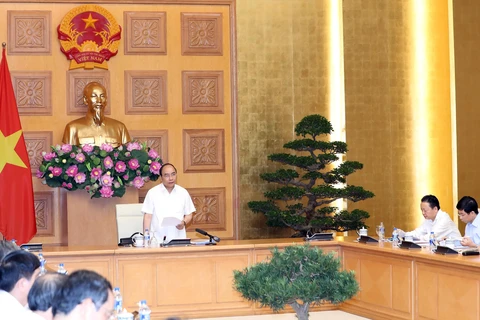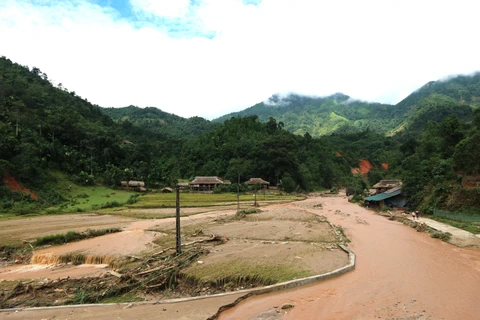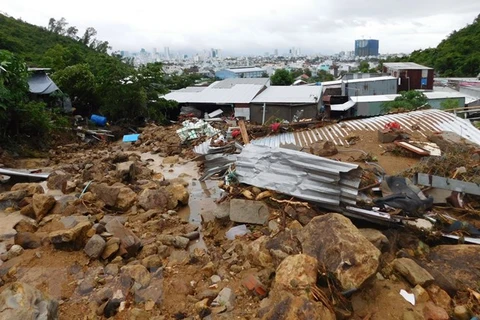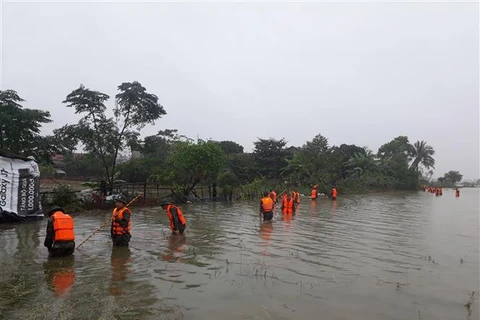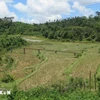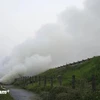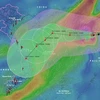 Local residents in the mountainous district Muong Lat in the north-central province of Thanh Hoa carry people across the flooded river during the historic 2018 August floods.(Photo: VNA)
Local residents in the mountainous district Muong Lat in the north-central province of Thanh Hoa carry people across the flooded river during the historic 2018 August floods.(Photo: VNA) Hanoi (VNS/VNA) - The central region of Vietnam usually bears the brunt of tropical storms that lash the country each year.
For generations, the people in this region have learnt to co-exist with the devastating floods every year, but to foretell when these disasters will occur to prevent loss of human life and minimise economic damage is the responsibility of hydro-meteorological observers, who have earned the title ‘flood watchers’.
However, for the north-central region, the most meaningful data is collected in remote mountainous areas like Lang Chang, Quan Hoa and Muong Lat districts in Thanh Hoa province, up the famous Ma River.
Amongst the 22 weather stations in Thanh Hoa, the Muong Lat hydrometeorological station is considered to have the “heaviest duty” – monitoring the slightest changes to the Ma River to tell if there flooding or landslides are imminent.
Just recently, in the midst of the dry season with mild winds reaching just 20-28km/h, the section of the Ma River passing through Ten Tan commune became a raging beast that evoked memories of epic past.
Observers at the Muong Lat station still needed to carry out at least eight measurements on the river a day, or even more if requested.
It could be said the role of the modern weather observer is far less epic, with their days mostly characterised by repeat routines, but there are still moments of danger that come as the rainy season hits.
The north central region has suffered from 19 forms of weather-related natural disasters over time, with the most prevalent involving tropical storms, thunderstorms, floods and heavy downpours.
According to Le Xuan Tinh, head of the Muong Lat station, 2018 was the most difficult year for the station’s workers, with spells of cold weather, tropical typhoons and heatwaves coming in succession.
Towards the end of August last year, Thanh Hoa and Nghe An suffered the worst floods they’d seen in years, with alarms of widespread inundation and flash floods sounded at the highest level.
Tinh said all five staff at the station were working round the clock and still dutifully collecting measurements to report to Thanh Hoa’s weather station, which were then transmitted to the national weather agency.
By 7am on August 30, the roads in front of and behind the observatory had vanished under the floodwater. Heavy rain felled telecommunications lines, and both phone services and internet connections were down throughout Muong Lat district.
Diep Huy Hoang, born in 1990, the youngest and arguably, fittest member at the observatory, was charged with a special duty – walking through rain-lashed mountainous terrain to reach the Lao border gate to ask the neighbouring country’s customs officials to send data to Thanh Hoo province.
It took more than a day for the internet connection to be restored and to start transmitting again.
“It was really fortunate. If we had been offline for any longer, I doubt even Hoang would have had enough stamina to make the journey,” Tinh said.
The Lang Chanh station is an old and waterlogged one-storey building that has not been renovated since it was built in 1990.
“In 2012, when the floods hit, the water reached nearly to the top of the station. Luckily, the station had a small room on the roof so we moved all the equipment up there, but all our personal belongings were swept away as we didn’t have enough time to move them,” said Nguyen Trung Kien, the station’s head.
Nguyen Van Luong, director of the North Central Meteorological Forecasting Agency, who has spent 30 years in the job, said: “Anyone who chooses the meteorological profession is aware of the struggles they will face, especially those working at mountainous border observatories."
For Luong, after graduating from the central meteorology college in Hanoi in 1985, he worked as an observer for 15 years at four stations in different rural districts in Thanh Hoa before he was promoted to head of the north-central region.
“I have gone through a lot, mostly struggles and difficult times. I always remind the stations’ staff that no matter the hardships, they must always deliver complete and accurate data on meteorological events and other environmental elements so they are never neglectful or late because this duty is their responsibility and pride of both the observers and the stations,” Luong said.
The Vietnamese Government, realising the importance of accurate and fast weather data to prevent human losses and economic damages in disaster-prone areas, has granted a significant budget to the forecasting sector, with the north-central region being one of the priorities.
Since 2012, the region has received state-of-the-art equipment from overseas – including 49 rain gauges from South Korea that use GPRS/GSM technology to ensure uninterrupted data transmission, three automatic ocean observatories and 11 wind stations in coastal areas in addition to one weather radar and one weather satellite system.
Starting in 2017, in the next phase of modernising forecasting facilities in Vietnam with financing from the World Bank, 82 automatic rainfall and water level gauges with European technologies were installed to replace the manual measuring system.
Aside from new equipment, the national weather agency has also attempted to mobilise funding both from domestic and foreign sources to improve the infrastructure at important weather stations.
The Hoi Xuan station in Quan Hoa district was recently rebuilt to provide staff with a proper working environment and better living quarters.
Nguyen Thi Hai Yen, 26, currently the youngest observer at the Hoi Xuan station, followed in her father’s footsteps to become a ‘flood watcher’ in this poor remote area.
“I could hardly believe that my station was being rebuilt into this new modern facility. It really helped consolidate our faith in the job and motivated us,” Yen said.
Similar to Hoi Xuan, the new Muong Lat station sits atop a windy hill and this sprawling complex is “another level” above the derelict old building.
Head of the station, Le Xuan Tinh, said it checked all the boxes and was just what weather service workers needed to “stay dedicated to the job in this poor, remote area”.-VNS/VNA
VNA
